 W
WBrunneria is a genus of praying mantises in Family Mantidae. They are often called stick mantis for their slender shape and the species of the genus are native to the Americas.
 W
WBrunneria borealis, common name Brunner's mantis, Brunner's stick mantis, or northern grass mantis, is a species of praying mantis native to the southern United States. It is the only mantis species known to reproduce solely through parthenogenesis; there are no males.
 W
WThe Carolina mantis is a species of praying mantis of the subfamily Stagmomantinae.
 W
WThe Chinese mantis is a species of mantis native to Asia and the nearby islands. In 1896 this species was accidentally introduced by a nurseryperson at Mt. Airy near Philadelphia, United States. Tenodera sinensis often is erroneously referred to as Tenodera aridifolia sinensis because it was at first described as a subspecies of Tenodera aridifolia, but Tenodera sinensis is now established as a full species.
 W
WChoeradodis is a genus of praying mantises with common names such as shield mantis, hood mantis, and leaf mantis because of their extended, leaf-like thoraces. The distinguishing characteristic of Choreododis from which it takes its common names is a laterally expanded thorax. This adaptation for the purpose of camouflage, as well as a rounded wing case and a habit of staying relatively flattened, aid its leaf mimicry.
 W
WChoeradodis rhombicollis, common name Peruvian shield mantis, is a species of praying mantis native to North America, Central America, and South America. It is found in Belize, Costa Rica, Ecuador, French Guiana, Guatemala, Colombia, Mexico, Nicaragua, Panama, Peru, and Surinam. It was formerly categorized as Choeradodis columbica (Beier 1931), as Choeradodis peruviana (Serville 1839), and as Mantis rhombicollis (Latreille 1833).
 W
WChoeradodis rhomboidea, common names tropical shield mantis, hood mantis, and leaf mantis, is a species of praying mantis. A native of Central America, C. rhomboidea was formerly categorized as Choeradodis hyalina (Serville 1831) and Mantis rhomboidea (Stoll 1813)
 W
WThe European mantis is a large hemimetabolic insect in the family of the Mantidae ('mantids'), which is the largest family of the order Mantodea (mantises). Their common name praying mantis is derived from the distinctive posture of the first pair of legs that can be observed in animals in repose. It resembles a praying attitude. Both males and females have elongated bodies with two pairs of wings. The most striking features that all Mantodea share are a very mobile, triangular head with large compound eyes and their first pair of legs, which is highly modified for the efficient capture and restraint of fast-moving or flying prey.
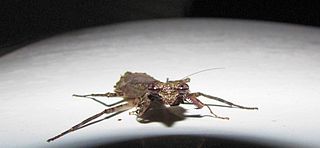 W
WGonatista is a genus of praying mantises in the family Epaphroditidae.
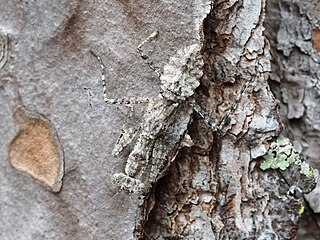 W
WGonatista grisea, common name grizzled mantis or lichen mimic, is a species of praying mantis native to the southern United States, primarily Florida.
 W
WIris oratoria, known by the common name Mediterranean mantis or iris mantis, is a widespread species of praying mantis native to Europe. It is found as an introduced species in the Middle East, Western Asia and the United States. Iris oratoria invaded southern California in the 1930s and seems to be spreading.
 W
WLitaneutria minor, or the agile ground mantis, is native to the drier regions of North America. L. minor is found in the United States in Colorado, Arizona to Mexico, and the eastern regions of Washington to California. They also can be found in Canada in the southern Okanagan Valley and are Canada's only native mantis. They are very active hunters and will be seen running across the ground from early spring to late summer.
 W
WMantoida is a genus containing eleven species of mantis. It is placed in family, Mantoididae.
 W
WMantoida nitida is a species of praying mantis in the Mantoididae family.
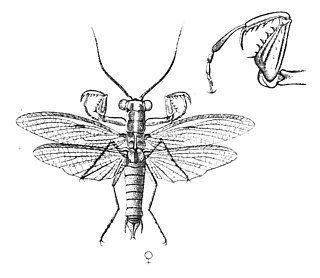 W
WMantoididae is a family of order Mantodea which contains Neotropical species of praying mantises from tropical North and South America. The family was formerly represented by the sole genus Mantoida, however the genus Paramantoida was described in 2014 and Vespamantoida in 2019. The family differs from the closely related Chaeteessidae in having an apical claw on the fore tibiae which are also less curved. Males have ocelli and a cylindrical body shape, unlike the dorsoventrally flattened Chaeteessidae. The cerci are also shorter.
 W
WOligonicella is a wide-ranging genus of mantises in the family Thespidae. It is represented in Africa, Asia, Europe, and North America.
 W
WPhyllovates chlorophaea, with the common name Texas unicorn mantis, is a species of praying mantis.
 W
WStagmomantis is a genus consisting of 27 species of mantises native to the Americas. There are 7 species of Stagmomantis native to the United States.
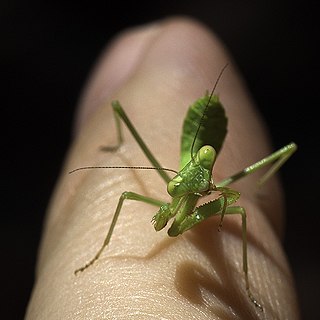 W
WStagmomantis californica, common name California mantis, is a species of praying mantis in the genus Stagmomantis native to the Western United States.
 W
WStagmomantis limbata, common name bordered mantis, bosque mantis, Arizona mantis, or New Mexico praying mantis is a species of praying mantis native to North America, most prevalent in the Southwestern United States. This beneficial insect is green or beige in color and grows up to around 3 inches long.
 W
WStagmomantis montana, common name Mountain mantis, is a species of praying mantis in genus Stagmomantis. They are native to Mexico and Central America. S. montana sinaloae has been identified as a subspecies.
 W
WTenodera angustipennis is a species of mantis native to Asia and nearby areas of Oceania. The species was introduced and became established in the eastern United States. Tenodera angustipennis was noticed as early as 1921 in Aberdeen, Maryland, but that occurrence was not noted in a published record until 1933.
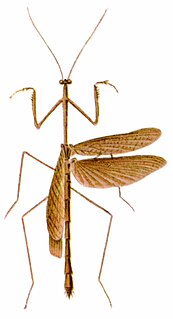 W
WThesprotia is a genus of mantises commonly known as grass mantis. They are native to the Americas and are represented by the following species:T. brasiliensis T. brevis T. caribea T. filum T. fuscipennis T. gigas T. graminis T. infumata T. insolita T. macilenta T. maculata T. pellucida T. simplex T. subhyalina
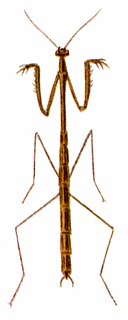 W
WThesprotia graminis, common name American grass mantis or grass-like mantis, is a species of praying mantis native to the Southern United States. It is found in Florida and Georgia. This species can reproduce parthenogenetically or through sexual reproduction. T. graminis is similar in appearance to Brunneria borealis.